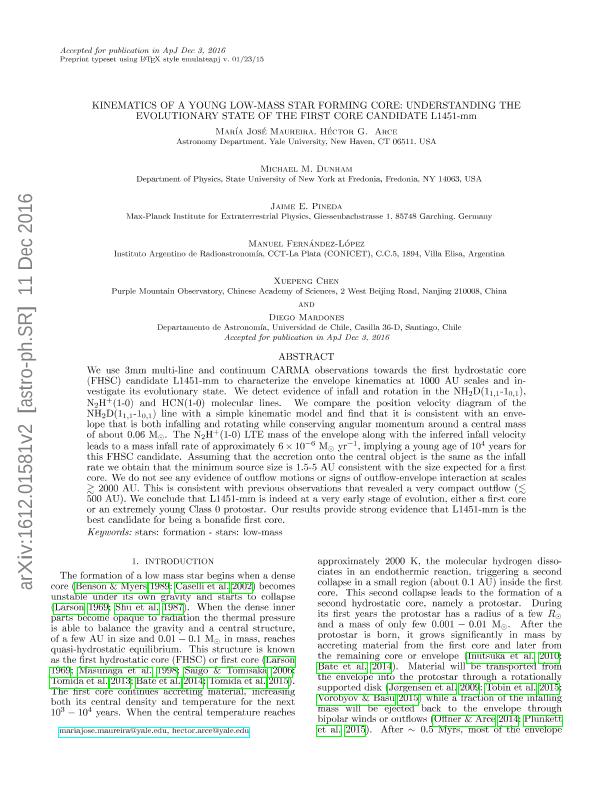Mostrar el registro sencillo del ítem
dc.contributor.author
Maureira, María José
dc.contributor.author
Arce, Héctor G.
dc.contributor.author
Dunham, Michael M.
dc.contributor.author
Pineda, Jaime E.
dc.contributor.author
Fernandez Lopez, Manuel

dc.contributor.author
Chen, Xuepeng
dc.contributor.author
Mardones, Diego
dc.date.available
2017-10-17T17:11:52Z
dc.date.issued
2017-03
dc.identifier.citation
Maureira, María José; Arce, Héctor G.; Dunham, Michael M.; Pineda, Jaime E.; Fernandez Lopez, Manuel; et al.; Kinematics of a Young Low-mass Star-forming Core: Understanding the Evolutionary State of the First-core Candidate L1451-mm; IOP Publishing; Astrophysical Journal; 838; 1; 3-2017; 1-16
dc.identifier.issn
0004-637X
dc.identifier.uri
http://hdl.handle.net/11336/26712
dc.description.abstract
We use 3 mm multiline and continuum CARMA observations toward the first hydrostatic core (FHSC) candidate L1451-mm to characterize the envelope kinematics at 1000 au scales and investigate its evolutionary state. We detect evidence of infall and rotation in the NH2D(11,1-10,1), N2H+(1-0), and HCN(1-0) molecular lines. We compare the position-velocity diagram of the NH2D(11,1-10,1) line with a simple kinematic model and find that it is consistent with an envelope that is both infalling and rotating while conserving angular momentum around a central mass of about 0.06 M o. The N2H+(1-0) LTE mass of the envelope along with the inferred infall velocity leads to a mass infall rate of approximately 6 ×10-6 M o yr-1, implying a young age of 104 years for this FHSC candidate. Assuming that the accretion onto the central object is the same as the infall rate, we obtain a minimum source size of 1.5-5 au, consistent with the size expected for a first core. We do not see any evidence of outflow motions or signs of outflow-envelope interaction at scales ≳2000 au. This is consistent with previous observations that revealed a very compact outflow (≲500 au). We conclude that L1451-mm is indeed at a very early stage of evolution, either a first core or an extremely young Class 0 protostar. Our results provide strong evidence that L1451-mm is the best candidate for being a bona fide first core.
dc.format
application/pdf
dc.language.iso
eng
dc.publisher
IOP Publishing

dc.rights
info:eu-repo/semantics/openAccess
dc.rights.uri
https://creativecommons.org/licenses/by-nc-sa/2.5/ar/
dc.subject
Star Formation
dc.subject
Low Mass
dc.subject.classification
Otras Ciencias Físicas

dc.subject.classification
Ciencias Físicas

dc.subject.classification
CIENCIAS NATURALES Y EXACTAS

dc.title
Kinematics of a Young Low-mass Star-forming Core: Understanding the Evolutionary State of the First-core Candidate L1451-mm
dc.type
info:eu-repo/semantics/article
dc.type
info:ar-repo/semantics/artículo
dc.type
info:eu-repo/semantics/publishedVersion
dc.date.updated
2017-10-04T14:54:45Z
dc.journal.volume
838
dc.journal.number
1
dc.journal.pagination
1-16
dc.journal.pais
Estados Unidos

dc.description.fil
Fil: Maureira, María José. University of Yale; Estados Unidos
dc.description.fil
Fil: Arce, Héctor G.. University of Yale; Estados Unidos
dc.description.fil
Fil: Dunham, Michael M.. State University of New York at Fredonia; Estados Unidos
dc.description.fil
Fil: Pineda, Jaime E.. Max Planck Institut Fur Extraterrestrische Physik; Alemania
dc.description.fil
Fil: Fernandez Lopez, Manuel. Provincia de Buenos Aires. Gobernación. Comisión de Investigaciones Científicas. Instituto Argentino de Radioastronomía. Consejo Nacional de Investigaciones Científicas y Técnicas. Centro Científico Tecnológico Conicet - La Plata. Instituto Argentino de Radioastronomía; Argentina
dc.description.fil
Fil: Chen, Xuepeng. Chinese Academy of Sciences; República de China
dc.description.fil
Fil: Mardones, Diego. Universidad de Chile; Chile
dc.journal.title
Astrophysical Journal

dc.relation.alternativeid
info:eu-repo/semantics/altIdentifier/doi/http://dx.doi.org/10.3847/1538-4357/838/1/60
dc.relation.alternativeid
info:eu-repo/semantics/altIdentifier/url/http://iopscience.iop.org/article/10.3847/1538-4357/838/1/60/meta;jsessionid=B0EC53E96380083B8293759AAF690085.ip-10-40-2-120
Archivos asociados
